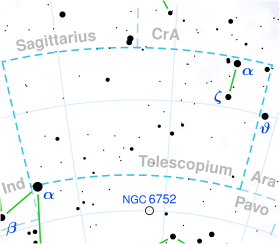HD 176664
| Observation data Epoch J2000.0 Equinox J2000.0 (ICRS) | |
|---|---|
| Constellation | Telescopium |
| Right ascension | 19h 03m 57.55905s[1] |
| Declination | −51° 01′ 06.9715″[1] |
| Apparent magnitude (V) | 5.93±0.01[2] |
| Characteristics | |
| Spectral type | K0/1 III[3] |
| B−V color index | +1.24[4] |
| Astrometry | |
| Radial velocity (Rv) | −60.2±0.4[5] km/s |
| Proper motion (μ) | RA: +40.300 mas/yr[1] Dec.: −147.992 mas/yr[1] |
| Parallax (π) | 11.1536 ± 0.0456 mas[1] |
| Distance | 292 ± 1 ly (89.7 ± 0.4 pc) |
| Absolute magnitude (MV) | +0.94[6] |
| Details | |
| Mass | 1.17[7] M☉ |
| Radius | 12.4±0.6[8] R☉ |
| Luminosity | 49.9±0.4[1] L☉ |
| Surface gravity (log g) | 2.42[7] cgs |
| Temperature | 4,546±122[9] K |
| Metallicity [Fe/H] | +0.25[10] dex |
| Rotational velocity (v sin i) | <1[11] km/s |
| Age | 377[1] Myr |
| Other designations | |
| Database references | |
| SIMBAD | data |
HD 176664, also known as HR 7190 or rarely 43 G. Telescopii, is a solitary star located in the southern constellation Telescopium. It is faintly visible to the naked eye as an orange-hued star with an apparent magnitude of 5.93.[2] The object is located relatively close at a distance of 292 light years based on Gaia DR3 parallax measurements[1] but is rapidly approaching the Solar System with a heliocentric radial velocity of −60 km/s.[5] At its current distance HD 176664's brightness is diminished by two-tenths of a magnitude due to interstellar dust.[14] It has an absolute magnitude of +0.94.[6]
HD 176664 has a stellar classification of K0/1 III, indicating that it is an evolved K-type star with a spectrum intermediate of a K0 and K1 giant star. It has a comparable mass to the Sun[7] but it has expanded to 12.4 times its girth.[8] It radiates 49.9 times the luminosity of the Sun[1] from its enlarged photosphere at an effective temperature of 4,546 K.[9] HD 176664 is metal enriched ([Fe/H] = +0.25) and spins too slowly to be measured accurately.[11] A 1993 paper by Olin J. Eggen lists HD 176664 as a member of the Milky Way's old disk population.[10]
The star has two optical companions designated CD −51°11893B and CD −51°11893C. B is a distant 13th magnitude star located 19.4" away along a position angle of 9° while C is a 12th magnitude star located 27.5" away along a position angle of 29°.[15]
References
[edit]- ^ a b c d e f g h Vallenari, A.; et al. (Gaia collaboration) (2023). "Gaia Data Release 3. Summary of the content and survey properties". Astronomy and Astrophysics. 674: A1. arXiv:2208.00211. Bibcode:2023A&A...674A...1G. doi:10.1051/0004-6361/202243940. S2CID 244398875. Gaia DR3 record for this source at VizieR.
- ^ a b Høg, E.; Fabricius, C.; Makarov, V. V.; Urban, S.; Corbin, T.; Wycoff, G.; Bastian, U.; Schwekendiek, P.; Wicenec, A. (March 2000). "The Tycho-2 catalogue of the 2.5 million brightest stars". Astronomy and Astrophysics. 355: L27–L30. Bibcode:2000A&A...355L..27H. ISSN 0004-6361.
- ^ Houk, Nancy (1978). Michigan catalogue of two-dimensional spectral types for the HD stars: Declinations −53° to −40°. Vol. 2. Bibcode:1978mcts.book.....H.
- ^ Johnson, H. L.; Mitchell, R. I.; Iriarte, B.; Wisniewski, W. Z. (1966). "UBVRIJKL Photometry of the Bright Stars". Communications of the Lunar and Planetary Laboratory. 4: 99–110. Bibcode:1966CoLPL...4...99J.
- ^ a b Gontcharov, G. A. (November 2006). "Pulkovo Compilation of Radial Velocities for 35,495 Hipparcos stars in a common system". Astronomy Letters. 32 (11): 759–771. arXiv:1606.08053. Bibcode:2006AstL...32..759G. doi:10.1134/S1063773706110065. eISSN 1562-6873. ISSN 1063-7737. S2CID 119231169.
- ^ a b Anderson, E.; Francis, Ch. (May 2012). "XHIP: An extended hipparcos compilation". Astronomy Letters. 38 (5): 331–346. arXiv:1108.4971. Bibcode:2012AstL...38..331A. doi:10.1134/S1063773712050015. eISSN 1562-6873. ISSN 1063-7737. S2CID 119257644.
- ^ a b c Anders, F.; et al. (August 2019). "Photo-astrometric distances, extinctions, and astrophysical parameters for Gaia DR2 stars brighter than G = 18". Astronomy & Astrophysics. 628: A94. arXiv:1904.11302. Bibcode:2019A&A...628A..94A. doi:10.1051/0004-6361/201935765. eISSN 1432-0746. ISSN 0004-6361.
- ^ a b Kervella, P.; Thévenin, F.; Di Folco, E.; Ségransan, D. (October 2004). "The angular sizes of dwarf stars and subgiants". Astronomy & Astrophysics. 426 (1): 297–307. arXiv:astro-ph/0404180. Bibcode:2004A&A...426..297K. doi:10.1051/0004-6361:20035930. eISSN 1432-0746. ISSN 0004-6361.
- ^ a b Stassun, Keivan G.; et al. (9 September 2019). "The Revised TESS Input Catalog and Candidate Target List". The Astronomical Journal. 158 (4): 138. arXiv:1905.10694. Bibcode:2019AJ....158..138S. doi:10.3847/1538-3881/ab3467. eISSN 1538-3881. hdl:1721.1/124721. S2CID 166227927.
- ^ a b Eggen, O. J. (July 1993). "Evolved GK stars near the sun. I - The old disk population". The Astronomical Journal. 106: 80. Bibcode:1993AJ....106...80E. doi:10.1086/116622.
- ^ a b De Medeiros, J. R.; Alves, S.; Udry, S.; Andersen, J.; Nordström, B.; Mayor, M. (January 2014). "A catalog of rotational and radial velocities for evolved stars V: Southern stars". Astronomy & Astrophysics. 561: A126. arXiv:1312.3474. Bibcode:2014A&A...561A.126D. doi:10.1051/0004-6361/201220762. eISSN 1432-0746. ISSN 0004-6361. S2CID 54046583.
- ^ Gould, Benjamin Apthorp (1878). "Uranometria Argentina : brillantez y posicion de las estrellas fijas, hasta la septima magnitud, comprendidas dentro de cien grados del polo austral : con atlas". Resultados del Observatorio Nacional Argentino. 1. Bibcode:1879RNAO....1.....G.
- ^ "HD 176664". SIMBAD. Centre de données astronomiques de Strasbourg. Retrieved February 3, 2023.
- ^ Gontcharov, George A.; Mosenkov, Aleksandr V. (28 September 2017). "Verifying reddening and extinction for Gaia DR1 TGAS main sequence stars". Monthly Notices of the Royal Astronomical Society. 472 (4): 3805–3820. arXiv:1709.01160. Bibcode:2017MNRAS.472.3805G. doi:10.1093/mnras/stx2219. eISSN 1365-2966. ISSN 0035-8711.
- ^ Mason, Brian D.; Wycoff, Gary L.; Hartkopf, William I.; Douglass, Geoffrey G.; Worley, Charles E. (December 2001). "The 2001 US Naval Observatory Double Star CD-ROM. I. The Washington Double Star Catalog". The Astronomical Journal. 122 (6): 3466–3471. Bibcode:2001AJ....122.3466M. doi:10.1086/323920. ISSN 0004-6256.

